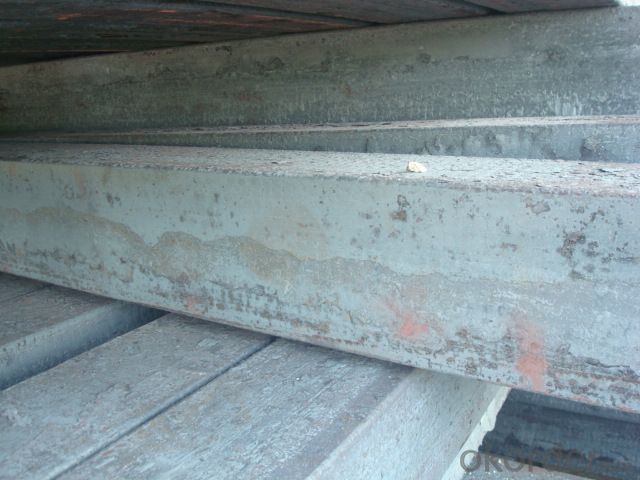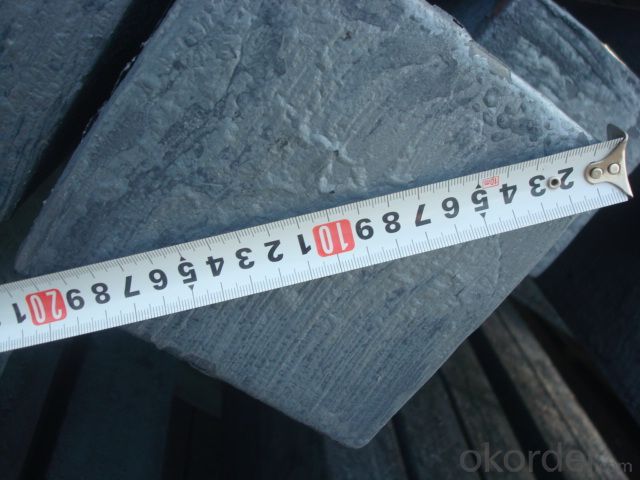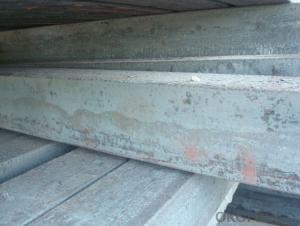Continue Casting Steel Bloom Made by Blast Furnace
- Loading Port:
- Tianjin
- Payment Terms:
- TT OR LC
- Min Order Qty:
- 1000 m.t.
- Supply Capability:
- 100000 m.t./month
OKorder Service Pledge
OKorder Financial Service
You Might Also Like
Continue Casting Steel Bloom Made by Blast Furnace
1.Structure of Continue Casting Steel Bloom Made by Blast Furnace
Continue Casting Steel Bloom Made by Blast Furnaceis the raw material of all kinds of steel products.For example, Billet section of square, round, flat, rectangular and abnormity, etc Several, mainly related to shape of rolled products. Simple rolled section steel, choose cross section of square billet or rectangular billet. rolling The sector products such as flat steel, Angle steel, select the rectangular billet or slab. There are diffirents kinds of the spec. for the steel billet, in the past, Many steel mill produce the steel billet by Electrice furnace, but now most of the steel billet manufactured by blast furnace.
2.Main Features of Continue Casting Steel Bloom Made by Blast Furnace
Continue Casting Steel Bloom by Blast Furnace section size is normally includes 120*120,130*130,150*150,160*160,165*165 and so on. And also includes the retangular size, it depands on the usage of the steel billet. simplify the stock management of workshop.
3. Continue Casting Steel Bloom Made by Blast Furnace Images


4. Continue Casting Steel Bloom Made by Blast Furnace Specification
Continue Casting Steel Bloom by Blast Furnace rolled steel, after processing can be used for mechanical parts, forging parts, processing all kinds of steel, steel Q345B channel steel, wire rod is the role of the billet. Steel billet is used in the production of semi-finished products, generally cannot be used directly for the society. Steel billets and steel are strictly divided into standard, cannot decide to whether the business enterprise of the final product, and according to unified standards to perform the whole society. Typically, billet and the steel is relatively easy to distinguish, but for some steel billet, and have the same specification and same steel purposes (such as rolling tube billet), whether can be used for other industries, whether through steel processing process, whether through a finished product rolling mill processing to distinguish
Material standard The editor Range of thickness: 150-240 - mm + / - 5 mm width range: 880-1530 - mm + / - 20 mm Length: 3700-10000 - mm + / - 500 - mm Cross-sectional size: 64 * 64; 82 * 82; 98 * 98; 124 * 124; 120 * 150; 152 * 164; 152 * 170 mm Length: 9000 mm Section of tolerance: billet: 1.0 + / - 2.0-1.0 + / - 1.0 mm slab: width: + / - 2.0 mm thickness: + / - 3.0 mm The length tolerance: + / - 200 mm Section diagonal tolerance: 3.5-8.0 MM Billet section size protrusions requirements: < 1242 mm, do not allow; > = 1242 mm, < = 2 mm 1242 mm, < = 3 mm Beheading (shear) extension deformation: < 1242 mm billet: no control; The slab: < = 15 mm Surface tilt: no more than billet section 0.1 Bending: every 1 m length is not more than 10 mm The distortion: length < = 5 m, < = 11. ; The length of the < = 7.5 M, < = 5. Material % 3 sp/PS chemical composition: C Mn Si S P
Mainly from the shape is divided into two kinds:Slab: cross section width and height of the ratio of the larger, mainly used for rolling plate.Billet: equal cross section width and height, or a huge difference, mainly used for rolling steel, wire rod.Material part of the standard:Range of thickness: 150-240 - mm + / - 5 mmThe width of the range: 880-1530 - mm + / - 20 mmLength: 3700-10000 - mm + / - 500 - mmCross-sectional size: 64 * 64;82 * 82;98 * 98;124 * 124;120 * 150;152 * 164;152 * 170 mm
5.FAQ of Continue Casting Steel Bloom Made by Blast Furnace
We have organized several common questions for our clients,may help you sincerely:
①Could we get the SGS Certificate with other documents together?
Yes you can if you pay the SGS inspecting fee in advanced, we will arrange that inspection for you before loading and will get the certificate then.
②If some quality problem happen, how long we can get the settlement?
about 7-30 days, depands on the situation of the cargo, if you report it earlier, it will be easier to check and get the result of inspecting, or you can apply the SGS inspecting.
③How many tons is the Minimum order quantity?
The Minimum order quantity is 1000tons, if your spec. is normal size, otherwise, need to comfirm with our steel mill for the detail order.
- Q:How are steel billets used in the production of industrial pumps?
- Steel billets are used in the production of industrial pumps as they serve as the raw material for creating the pump's main components, such as the pump body and impeller. These billets are melted, cast, and then forged or machined into the desired shapes and sizes to form the pump's robust and durable structure.
- Q:What are the typical dimensions and weight of steel billets?
- The typical dimensions and weight of steel billets can vary depending on the specific requirements of the industry or application. However, in general, steel billets are rectangular in shape and have a length that is several times its width and height. The dimensions of steel billets commonly range from around 100mm to 200mm in width, 100mm to 300mm in height, and 3,000mm to 6,000mm in length. These dimensions can vary based on the intended use, as different industries may have specific requirements for their steel billets. Regarding weight, steel billets typically range from a few hundred kilograms to several metric tons. The weight depends on various factors, including the dimensions, density, and grade of steel used. It is important to note that steel billets can be customized to meet specific weight requirements, especially in industries such as construction, automotive, and manufacturing, where precise weight specifications are necessary. Overall, the dimensions and weight of steel billets can vary based on industry needs, but they generally adhere to rectangular shapes and can range from hundreds of kilograms to several metric tons.
- Q:What are the common applications of steel billets?
- Steel billets are semi-finished products that are used in various industrial applications. Some of the common applications of steel billets are: 1. Construction: Steel billets are widely used in the construction industry for structural purposes. They are used to manufacture beams, columns, and other load-bearing components in buildings, bridges, and other structures. The high strength and durability of steel billets make them ideal for withstanding heavy loads and providing structural integrity. 2. Automotive Industry: Steel billets are extensively used in the automotive industry for manufacturing various components such as crankshafts, camshafts, connecting rods, and gears. The excellent mechanical properties of steel billets ensure the reliability and performance of these critical automotive parts. 3. Machinery and Equipment Manufacturing: Steel billets are used in the production of machinery and equipment. They are utilized for manufacturing parts like gears, shafts, valves, and hydraulic cylinders. The versatility of steel billets allows for the customization of these components to meet specific operational requirements. 4. Electrical Industry: Steel billets find applications in the electrical industry for the production of electrical transformers and electric motor cores. The high magnetic permeability and electrical conductivity of steel make it an ideal material for these applications. 5. Pipe Manufacturing: Steel billets are commonly used in the manufacturing of pipes and tubes. They are processed through various techniques such as hot rolling, cold rolling, and extrusion to produce seamless or welded pipes. The strength and corrosion resistance of steel billets make them suitable for transporting fluids and gases in industries like oil and gas, water supply, and construction. 6. Shipbuilding: Steel billets are crucial in shipbuilding due to their strength, durability, and resistance to corrosion. They are used to manufacture various ship components such as hulls, frames, and bulkheads. The ability of steel billets to withstand harsh marine environments makes them an ideal choice for constructing ships and offshore structures. Overall, steel billets are versatile materials that find applications in a wide range of industries, thanks to their excellent mechanical properties, durability, and ability to be customized to meet specific requirements.
- Q:What are the main challenges in the handling of steel billets during production?
- The main challenges in handling steel billets during production include ensuring proper transportation and storage to prevent damage, maintaining consistent temperature and humidity conditions to avoid material distortion or degradation, and implementing efficient handling techniques to minimize product loss and maximize productivity. Additionally, handling heavy and bulky billets can pose risks to worker safety, demanding proper training and equipment to mitigate potential accidents.
- Q:What are the different types of steel billets used in the manufacturing industry?
- There are several different types of steel billets used in the manufacturing industry, including carbon steel billets, alloy steel billets, stainless steel billets, and tool steel billets. Each type of billet has its own unique composition and properties, making them suitable for various applications in industries such as construction, automotive, and aerospace.
- Q:How do steel billet prices fluctuate in the market?
- The market for steel billets experiences fluctuations in prices due to various factors. One of the primary factors is the demand and supply dynamics within the steel industry. When there is a high demand for steel billets, suppliers can increase prices as they have more leverage. Conversely, when there is low demand, suppliers may lower prices to compete for a smaller pool of buyers. The cost of raw materials is another significant factor impacting steel billet prices. Steel production relies on iron ore, coal, and scrap metal, and any changes in the prices of these materials directly affect the cost of producing steel billets. For instance, if there is a shortage of iron ore, the production costs rise, leading to an increase in the price of steel billets. Furthermore, market conditions and economic factors also influence steel billet prices. Inflation, interest rates, and currency exchange rates can affect the overall production and transportation costs, thereby influencing the prices of steel billets. Moreover, geopolitical events and trade policies can cause price fluctuations. Tariffs, trade disputes, or changes in import/export regulations can disrupt the supply chain, impacting the prices of steel billets. In conclusion, the prices of steel billets are influenced by a complex interplay of factors, including demand and supply dynamics, raw material costs, market conditions, and geopolitical events. Traders, manufacturers, and investors closely monitor these factors to predict and respond to price fluctuations in the steel billet market.
- Q:What is the role of steel billets in the manufacturing of construction excavators?
- Steel billets play a crucial role in the manufacturing of construction excavators. These billets, which are essentially semi-finished steel products in the form of a rectangular solid, serve as the primary raw material for constructing various components of excavators. One key aspect of steel billets is their high strength and durability. The construction industry demands materials that can withstand heavy loads, intense pressure, and harsh working conditions. Steel billets possess these characteristics, making them ideal for manufacturing excavators that are capable of withstanding the rigors of construction sites. During the manufacturing process, steel billets are heated and shaped into various components of the excavator. These components include the mainframe, booms, arms, and buckets – all of which require high-strength materials to ensure structural integrity and longevity. Additionally, steel billets allow for precise customization and fabrication. Manufacturers can mold and shape the billets into specific sizes and dimensions required for different parts of the excavator. This flexibility ensures that the components fit together seamlessly, enhancing the overall performance and functionality of the machine. Furthermore, steel billets provide excellent weldability. As excavators undergo constant stress and movements, welding is a crucial process for joining the various components. Steel billets enable strong and reliable welds, ensuring that the excavator remains structurally sound and capable of performing heavy-duty tasks. Overall, the role of steel billets in the manufacturing of construction excavators is indispensable. Their high strength, durability, customizability, and weldability make them the ideal raw material for constructing the robust and reliable machines that are required for the demanding nature of the construction industry.
- Q:What are the potential applications of steel billets in the medical sector?
- Steel billets have a range of potential applications in the medical sector, including the production of surgical instruments, orthopedic implants, and medical equipment. The durability and strength of steel make it suitable for manufacturing tools and devices that require high precision and reliability. Additionally, steel's resistance to corrosion and ability to be sterilized are valuable properties for medical applications.
- Q:How are steel billets used in the manufacturing of heavy machinery?
- Steel billets are used in the manufacturing of heavy machinery as they serve as the raw material for forging, casting, and machining processes. These billets are heated, shaped, and transformed into various components such as gears, shafts, frames, and structural parts, which are essential building blocks for constructing heavy machinery. The high strength and durability of steel billets make them ideal for withstanding the heavy loads and harsh conditions that heavy machinery often operates in.
- Q:How are steel billets used in the production of oil and gas pipelines?
- Steel billets are essential in the production of oil and gas pipelines as they serve as the initial material for manufacturing these pipelines. Essentially, steel billets are semi-finished steel products that typically have a rectangular or square shape. To manufacture oil and gas pipelines, a series of manufacturing processes are performed on the steel billets. Initially, the billets are heated to high temperatures in a furnace in a process known as billet heating. This heating process increases the malleability of the steel, making it easier to shape. Once the desired temperature is reached, the billets are then passed through a series of rollers to transform their shape into a cylindrical form. This process, called hot rolling, further enhances the mechanical properties of the steel, making it stronger and more durable. Following hot rolling, the steel goes through a process known as quenching and tempering. Quenching involves rapidly cooling the steel to increase its hardness, while tempering is a heat treatment process that reduces the brittleness of the steel, making it less prone to cracking. After these processes, the steel billets are welded together to form the final pipeline. This welding process ensures the integrity and strength of the pipeline, enabling it to withstand the high pressures and harsh environments associated with oil and gas transportation. In conclusion, steel billets play a crucial role in the production of oil and gas pipelines. They serve as the foundational material and undergo various manufacturing processes to transform into durable and high-strength pipes that efficiently transport oil and gas over long distances.
1. Manufacturer Overview |
|
|---|---|
| Location | |
| Year Established | |
| Annual Output Value | |
| Main Markets | |
| Company Certifications | |
2. Manufacturer Certificates |
|
|---|---|
| a) Certification Name | |
| Range | |
| Reference | |
| Validity Period | |
3. Manufacturer Capability |
|
|---|---|
| a)Trade Capacity | |
| Nearest Port | |
| Export Percentage | |
| No.of Employees in Trade Department | |
| Language Spoken: | |
| b)Factory Information | |
| Factory Size: | |
| No. of Production Lines | |
| Contract Manufacturing | |
| Product Price Range | |
Send your message to us
Continue Casting Steel Bloom Made by Blast Furnace
- Loading Port:
- Tianjin
- Payment Terms:
- TT OR LC
- Min Order Qty:
- 1000 m.t.
- Supply Capability:
- 100000 m.t./month
OKorder Service Pledge
OKorder Financial Service
Similar products
New products
Hot products
Related keywords





























